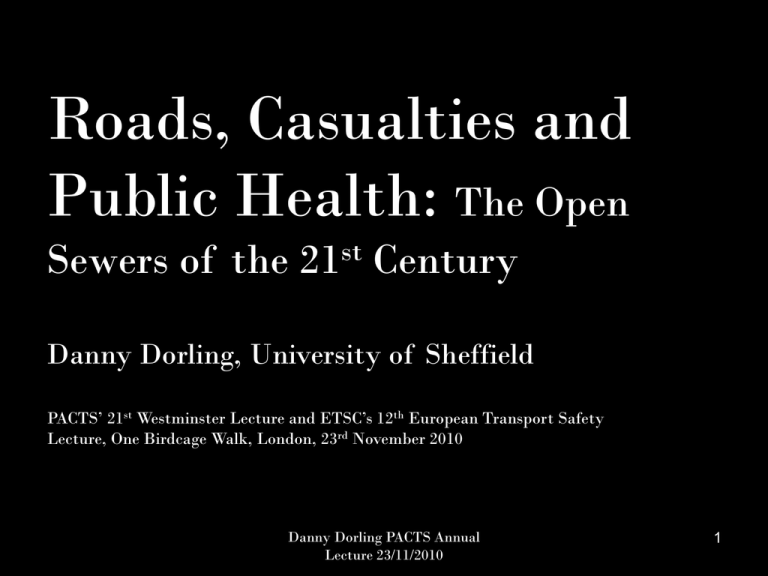
Roads, Casualties and
Public Health: The Open
Sewers of the 21st Century
Danny Dorling, University of Sheffield
PACTS’ 21st Westminster Lecture and ETSC’s 12th European Transport Safety
Lecture, One Birdcage Walk, London, 23rd November 2010
Danny Dorling PACTS Annual
Lecture 23/11/2010
1
“…there is no doubt that the number of road deaths worldwide per annum
is astonishingly huge. In the worst-case scenarios (which include
pollution and extrapolated deaths in nations which don't record specific
car-related incidents) the estimate is 2.4m people killed due to motor
vehicles every year. This exceeds easily the annual military death toll
from the First World War. Even the most conservative estimates – which
include only road deaths reported in developed nations and only down to
direct motor-vehicle accident – put the current annual road-death toll at
100,000 per year.
Within six months of the September 11 attacks on New York and
elsewhere, it is estimated that the number of people subsequently killed
on the roads who chose not to fly because of the chance of a repeat
atrocity had well exceeded the death toll caused by the terrorists on that
day, an unintended and gruesome consequence of their actions.
It is clear that humans have a blind spot when it comes to road deaths…”
Michael O'Hare, Northwood, Middlesex, Letters, The Independent, 23/11/2010
http://www.independent.co.uk/opinion/letters/letters-how-animals-are-killed-2141067.html
Danny Dorling PACTS Annual
Lecture 23/11/2010
2
My argument this evening
Every century comes with a major public health
warning about the harm that we inflict on
ourselves. In Britain in the nineteenth century it
was the diseases we spread by tolerating open
sewers. In the twentieth century it was tobacco
that we slow learnt to love then fear. In the twenty
first century it is the way we tolerate how cars are
allowed to travel on our roads
Danny Dorling PACTS Annual
Lecture 23/11/2010
3
Manchester
178 years ago
Little Ireland
From:
“The Condition of the
Working Class of
England”, Friedrich
Engels, 1845
Marx and Engels Collected
Works: Volume 04, 1844-45
http://www.marxists.org/archive/
marx/works/cw/volume04/i
ndex.htm
“Map of Manchester”
who went on to
observe….
Danny Dorling PACTS Annual
Lecture 23/11/2010
4
A German Tourist in 1842, writes…
“As I passed through the dwellings of the mill-hands
in Irish Town, Ancoats, and Little Ireland … found
a whole street following the course of a ditch,
because in this way deeper cellars could be secured
without the cost of digging, cellars not for storing
wares or rubbish, but for dwellings for human
beings. Not one house of this street escaped the
cholera.”
Danny Dorling PACTS Annual
Lecture 23/11/2010
5
Children suffering diarrhoea (today)
82 million aged 0-5
(http://www.worldmapper.org/ map 233)
Danny Dorling PACTS Annual
Lecture 23/11/2010
6
We know about sewers – we led the way in
public health, because we had to:
Manchester’s life expectancy from 1801 to 1850 was the
lowest ever seen recorded (bar pandemic), calculated at 25.3
years, affecting a population of 235,000 people in 1841 (*table
3)
– In Liverpool registration district itself, life expectancy in the 1880s was only
29 years of life, some 19 years lower than the 48 years recorded then in the
affluent Clifton district of Bristol (ibid, table 2). In Glasgow in earlier years
similarly low rates as in Liverpool were recorded, as low as age 27 around
1840 (ibid, table 5).
*Szreter, S. and Mooney, G., 1998, Urbanization, mortality, and the standard of living debate: new estimates of
the expectation of life at birth in nineteenth-century British cities, Economic History Review, 51, 1, 84-112
Danny Dorling PACTS Annual
Lecture 23/11/2010
7
People dying with diarrhoea (now)
1,871,441 people ,all ages each year
(http://www.worldmapper.org/ map 379
Danny Dorling PACTS Annual
Lecture 23/11/2010
8
In Britain the inequality gap is now 12.4 years,
despite having dealt with sewage by today
Now = life expectancy
between extreme districts
by 2009 … (was 12.45 in
2008 )
14
13
Difference between best
and worst-off districts by
life expectancy (years):
People
12
See: Thomas, B., Dorling,
D. and Davey Smith, G.
(2010). Inequalities in
premature mortality in
Britain: observational
study from 1921 to 2007,
BMJ, Friday 23rd July.
11
10
9
8
7
6
1999 2000 2001 2002 2003 2004 2005 2006 2007 2008
Danny Dorling PACTS Annual
Lecture 23/11/2010
http://www.sasi.group.shef
.ac.uk/publications/2010/T
homasDorlingDaveySmith
_2010_BMJ.pdf
9
It took 100 years to deal with sewage:
People dying with Polio now
Only
831 people a year and falling rapidly
(http://www.worldmapper.org/ map 3784
Danny Dorling PACTS Annual
Lecture 23/11/2010
10
For life expectancy inequality in Britain
We now have to return to the 1880s to find greater
gaps than those found today. The lowest life
expectancy recorded in the country then was just
thirty-six years in Liverpool. In Bristol it was then
ten years higher.
(Szreter and Mooney table 1)
Then the cause was sanitation, unemployment and
appalling employment. Now a different pandemic:
Danny Dorling PACTS Annual
Lecture 23/11/2010
11
People dying on the roads now
1,195,339 people a year
(http://www.worldmapper.org/ map 475
Danny Dorling PACTS Annual
Lecture 23/11/2010
…and rising rapidly
12
Poverty, sanitation, health, inequality - pioneers:
• Friedrich Engels (communist) 1820-1895
• Charles Booth (philanthropist) (1840-1916)
• Beatrix Potter (later Webb) (1858-1943)
• Seebohm Rowntree (Quaker) (1871-1954)
• Richard Doll (epidemiologist) (1912-2005)
• and Peter Townsend (sociologist) (1928-2009)
Danny Dorling PACTS Annual
Lecture 23/11/2010
13
But still we have to explain:
“Why income inequality is
of relevance to all
Londoners, especially at
a time when the capital is
not only still recovering
from the recession but
also facing severe cuts in
public sector spending”
1 in 10 of whose babies died in 1901 because they tolerated poverty
Danny Dorling PACTS Annual
Lecture
23/11/2010
by 1901 we were finally learning
about
germs and sewage
14
And we now
have to
explain that
poverty,
inequality and
disrespect
kills. In almost
exactly the
same way as
we had to
explain that
smoking kills
Age
The smoking
cloud shown
here of men
dying so much
more often in
early old age
in the 1970s
than did
women.
(seen in the record
of how many men
die each year of each
age as compared to
women in all rich
countries)
Sex Ratio of Mortality, Rich World (male rate / female rate)
100
3.4
3.3
3.2
3.1
3.0
2.9
2.8
2.7
2.6
2.5
2.4
2.3
2.2
2.1
2.0
1.9
1.8
1.7
1.6
1.5
1.4
1.3
1.2
1.1
1.0
90
80
70
60
50
40
30
20
10
0
1850 1860 1870 1880 1890 1900 1910 1920 1930 1940 1950 1960 1970 1980 1990 2000
Rigby, J.E. and Dorling, D. (2007). Mortality in
relation to sex in the affluent world. Journal of
Epidemiology and Community Health, 61(2)
Year
Danny Dorling PACTS Annual
Lecture 23/11/2010
This is new and the roads
become preeminent locations of
younger death explain some of it
15
If we turn to today we find a new crisis
“In June 2010 the Department for Communities and
Local Government published what is likely to
become one of the most infamous documents of the
economic depression/recession. It was titled: 'Local
government contribution to efficiencies in 2010/11”
(Dorling and Thomas, forthcoming, “Bankrupt Britain” Atlas, Bristol :Policy Press – the source for all
of the charts which now follow – based in turn on mortality data for 2006-2007 by cause )
Roads trap affluent children in their homes and are
the main site of killing of poorer children. What is
key is how large this contribution to death has
become:
Danny Dorling PACTS Annual
16
Lecture 23/11/2010
2006–07 external causes of death of 5 to 10
year olds, Britain:
Danny Dorling PACTS Annual
Lecture 23/11/2010
17
We reveal our ignorance in our priorities
“…the cuts this document specified will result in
more people, and especially young children, being
killed. That is because road safety funding is to be
cut by £37 million: 'Road safety funding £37.797m. £20.592m is proposed to be removed
from road safety revenue grant (paid out via area
based grant) in the last four months of 2010/11 and
£17.205m road safety capital grant originally due
to be paid in May. This represents a reduction of 27
per cent in the revenue grant and all of the capital
grant.‘” (Dorling and Thomas, forthcoming, 2011)
Danny Dorling PACTS Annual
Lecture 23/11/2010
18
2006–07 all causes of death of 11 to 16 year
olds, Britain
Danny Dorling PACTS Annual
Lecture 23/11/2010
19
We need to know what to fear most
We are now so protective of very young children –
those aged 5 to 9 – that more die due to disease
today than as pedestrians. However, dying as a
pedestrian has been the greatest threat to children
aged 5 to 9 in Britain for most of the last two
decades. Still, by age 10, car drivers are the greatest
danger to children. This is still found today when
all risk categories are compared.
Danny Dorling PACTS Annual
Lecture 23/11/2010
20
2006–07 external causes of death of 11 to 16
year olds, Britain
Danny Dorling PACTS Annual
Lecture 23/11/2010
21
The threat reduces our freedom to move as
children, we become more socially isolated
By the onset of adulthood the car and a small
number of cases of suicide together account for
half of all deaths at these young ages: nine deaths a
week of 17, 18 and 19 year olds from these causes
alone, almost all due to cars and their drivers. The
numbers of deaths per week from such causes
continues to rise throughout young adults'
twenties, only falling relative to other risks when
these young adults reach their late thirties
Danny Dorling PACTS Annual
Lecture 23/11/2010
22
2006–07 all causes of death of 17 to 19 year
olds, Britain
Danny Dorling PACTS Annual
Lecture 23/11/2010
23
The threat is not diminishing
Around 30,000 people of all ages are killed or
seriously injured on roads in Britain every year. In
2008 some 27,855 thousand cars were registered to
be driven on the country's roads. That rose slightly
to 27,868 during 2009 (partly with government
encouragement for new car buying with a 'scrapage
scheme’). Very young adults now cycle less.
Danny Dorling PACTS Annual
Lecture 23/11/2010
24
2006–07 external causes of death of 17 to 19
year olds, Britain
Danny Dorling PACTS Annual
Lecture 23/11/2010
25
Public health measures have begun to be
introduced very slowly:
“We want to encourage highway authorities to
introduce, over time, 20 mph zones or limits into
streets which are primarily residential in nature and
into town or city streets where pedestrian and
cyclist movements are high, such as around schools,
shops, markets, playgrounds and other areas, …
We want to draw attention to the initial
evidence from the trial of wide area signed-only
20mph limits in Portsmouth, and want to make
clear that 20 mph limits over a number of roads
may be appropriate elsewhere.” (DfT circular December 2009)
Danny Dorling PACTS Annual
Lecture 23/11/2010
26
2006–07 all causes of death of 20 to 24 year
olds, Britain
Danny Dorling PACTS Annual
Lecture 23/11/2010
27
Despite now having the medical evidence
“The introduction of 20 mph zones was associated
with a 41.9% (95% confidence interval 36.0% to 47.8%)
reduction in road casualties, after adjustment for
underlying time trends. The percentage reduction was
greatest in younger children and greater for the category
of killed or seriously injured casualties than for minor
injuries. There was no evidence of casualty migration to
areas adjacent to 20 mph zones, where casualties also
fell slightly by an average of 8.0%”
Grundy, C. et al. 2009, Effect of 20 mph traffic speed zones on road injuries in London, 1986-2006: controlled
interrupted time series analysis, BMJ, 2009;339:b4469
doi:10.1136/bmj.b4469
Danny Dorling PACTS Annual
Lecture 23/11/2010
28
2006–07 external causes of death of 20 to 24
year olds, Britain
Danny Dorling PACTS Annual
Lecture 23/11/2010
29
We are starting
to learn, just
as we did in
1848 with the
first
Public Health
Act
Location of 20 mph speed
zones in London (1991-2007),
(but will it take 100 years again
before we see the full effect?)
Grundy, C. et al. 2009, Effect of 20 mph
traffic speed zones on road injuries in
London, 1986-2006: controlled interrupted
time series analysis, BMJ, 2009;339:b4469
doi:10.1136/bmj.b4469
Danny Dorling PACTS Annual
Lecture 23/11/2010
30
“Road danger, middle ages men and affluence
the biggest causes”
PRESS RELEASE ROAD DANGER, MIDDLE AGED MEN AND AFFLUENCE BIGGEST CAUSES OF DEATH AND INJURY ON BRITAIN´S ROADS
• 16 September 2010
Young people called on to protest at next week´s World Safety
Conference.
• The World Safety Conference (http://www.safety2010.org.uk/) which opens
• in London next week is set to point the finger of blame for road traffic
• crashes on the victims of those crashes, rather than tackling the root cause,
• which is dangerous road traffic, says Dr Ian Roberts, Trustee of Road Peace
• (the UK national charity for the victims of road traffic crashes) and professor
• of public health at the London School of Hygiene and Tropical Medicine.
This press release can be downloaded from our website:
http://www.roadpeace.org/resources/PR_20100815_Road_danger_middle_aged_men_
and_affluence.pdf
Danny Dorling PACTS Annual
Lecture 23/11/2010
31
We will remember the dates in the future:
• When we re-ordered the priority of vehicles so that
blame is presumed on the larger and cars stop when
children stand by the road (as in Switzerland)
• When we pedestrianised* city centres as a matter
of course and required reasons for 30mph and
above wherever people walk and cycle
• When road safety became a DoH, not DfT issue
* “pedestrianised is not a word in the US dictionary
Or in Powerpoint in English English! Danny Dorling PACTS Annual
Lecture 23/11/2010
32
Local authority funding by intervention type
– what we may cut
Thameside
Total (National)
£280,000
£2,030,000
Play schemes including traffic calming in
vicinity and safer access
Pedestrian/cyclist facilities
£1,327,000
Engineering and traffic calming
£100,000
£5,347,000
Education, publicity and training
£91,000
£1,510,500
Home Zones
£200,000
£431,000
Watchman/VMS speed enforcement
£90,000
£341,200
Diversionary activities (clubs)
£30,000
£119,000
Christie, N. et al, “Road Safety
Web Publication No. 19
Road Traffic Injury Risk in
Disadvantaged Communities:
Evaluation of the Neighbourhood
Road Safety Initiative (DfT, 2010)
Table A1.1 from appendix I
My added words in yellow,
Thameside just shown as example
Car-seat schemes
£85,000
Research
£21,800
Total Budget
Danny Dorling PACTS Annual
Lecture 23/11/2010
£791,000
£11,200,500
33
Just as it took us to the 1950s to begin to get
sewage off our beaches…. So:
“While most children are injured on the residential
roads, these make up about 80% of the road length
in the NRSI areas. When this is accounted for, the
risk to the children is highest on the main roads. It
is especially high per head of population of young
people aged 16–24 years. The implication of this is
that as much attention should be paid to pedestrian
safety for people of all ages on main roads as on the
residential network “ (Christie, et al. 2010)
Danny Dorling PACTS Annual
Lecture 23/11/2010
34
We will look back and wonder what we were
thinking
Accidents involving cars are responsible for more deaths
among children and young adults in Britain than can be
attributed to any other causes. Just as open sewers were
once seen as convenient and cheap, if a little loathsome, and
tobacco was once widely tolerated, at some point in the
future the antisocial and only very personal and short-term
benefits of personal residential car transport will be more
widely recognised. Cars provide instant gratification. A car
standing on the drive outside of ‘your’ house is widely seen
as a sign of success. But what is one person immediate
convenience is a town’s congestion and a country’s major
killer. …Even before considering fumes, oil and car debt.
Danny Dorling PACTS Annual
Lecture 23/11/2010
35
We become attuned to stupidity
If you had suggested in 1810, at the very start of the
industrial revolution, that in a centuries time the open
sewers would have been covered over, fresh water would be
piped to houses, Individual latrines built for every property;
they would have thought you mad.
If you had suggested too strongly in 1910, just before the First
World War made cigarette smoking the national pass-time,
that in a century most adults would no longer smoke and it
might even be illegal to smoke in any public building; they
might have certified you.
Danny Dorling PACTS Annual
Lecture 23/11/2010
36
Conclusion
If you suggest in 2010 that within a century we will no longer
live in towns and villages choked by cars, paving over
gardens, even if all cars are electrically powered by batteries
recharged from wind-farms; they might accuse you of
taking a flight of fantasy.
However, what remains the same over time is our intolerance
of suffering, of ourselves and those around us. Slowly, one
by one, the causes of the greatest damage to health are
progressively removed. This lecture brought together maps,
statistics and arguments to suggest that we should now view
our road transport system in this way – as the greatest
current avoidable toll on public health
Danny Dorling PACTS Annual
Lecture 23/11/2010
37










